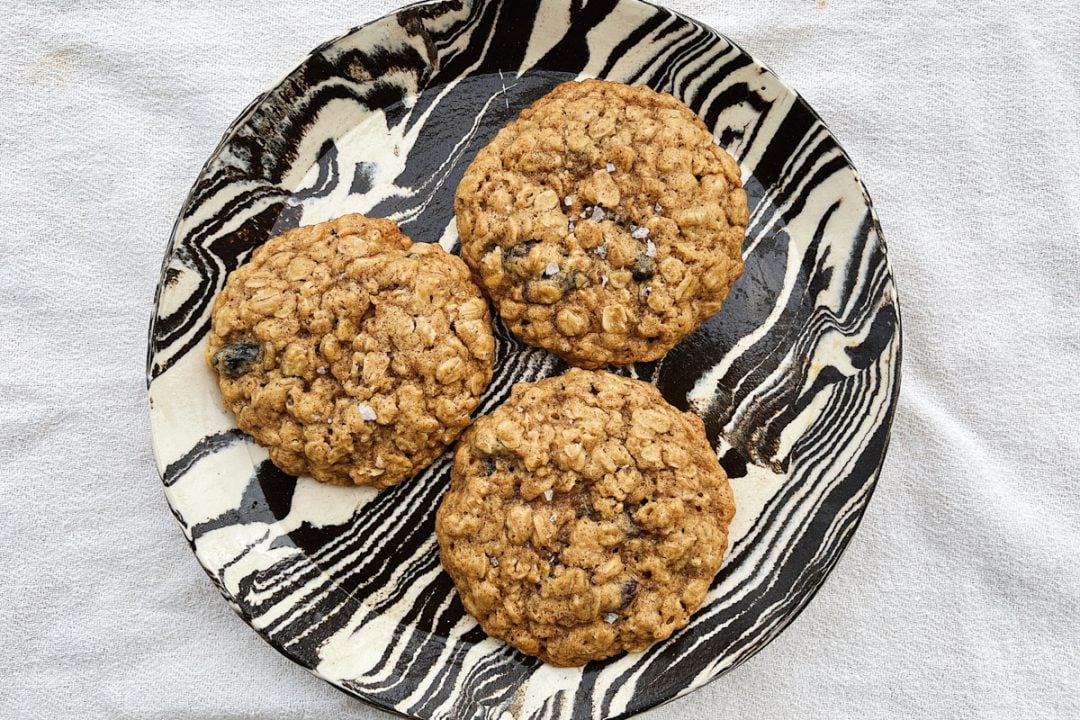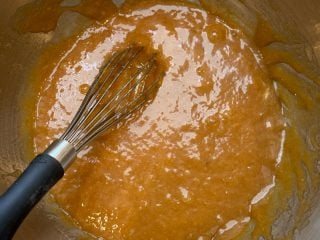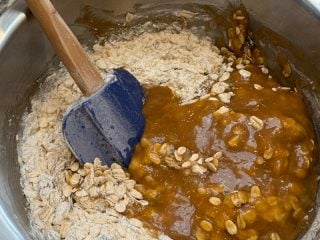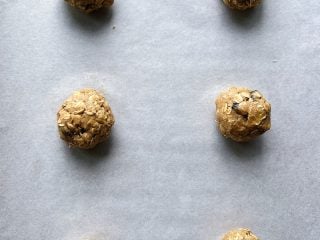Though perhaps often overshadowed by flashier treats in the bakery case, the humble oatmeal raisin cookie’s presence remains constant—and for many, beloved. They’re nubby-textured, starchy, richly sweet, and often warm-spiced. Though oatmeal cookies are comparable to other cookies in terms of ingredients, they somehow feel perfectly acceptable to eat for breakfast, which makes it fly to the top of my treat-list.
Most likely inspired by crumbly Scottish and British oat biscuits or oatcakes, Fannie Farmer’s 1896 Boston Cooking-School Cook Book is typically credited with publishing the first “oatmeal cookie” recipe; though some note that another popular 19th-Century cookbook author, Eliza Leslie, published recipes for cookies with oats beforehand. By 1908, Quaker Oats began featuring an “oat cakes” recipe on their boxes, which eventually morphed into their infamous “Vanishing Oatmeal Raisin Cookies.”
While there are no shortage of oatmeal raisin cookie recipes out in the world, we had to develop our own version for TPL, which of course include some sourdough starter discard. The resulting cookies are chewy and perfectly sweet, and very hard to eat just one at a time.
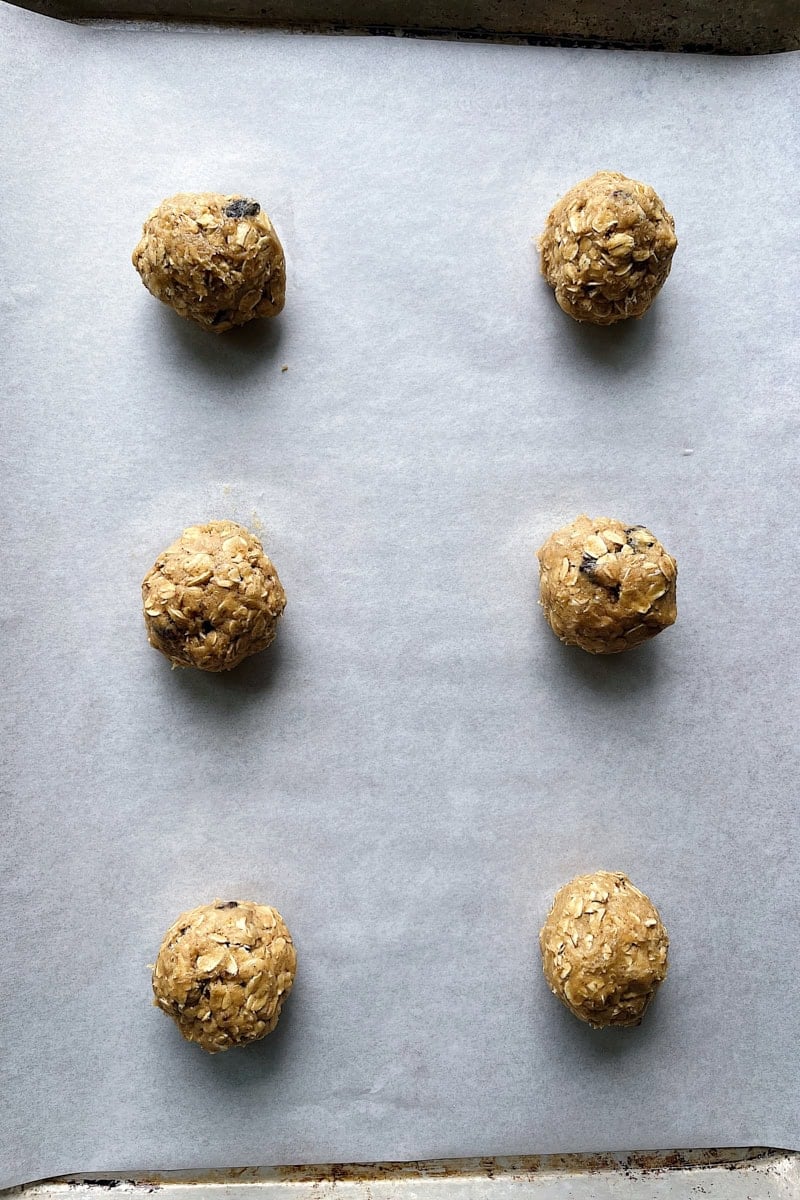
Start With A Bakers’ Ratio, But Tweak to Your Preferences
A standard cookie ratio is 3 parts flour to 2 parts fat to 1 part sugar (plus eggs for binding, chemical leavener for lift, and salt for seasoning). I personally prefer an oatmeal raisin cookie that’s on the chewier side, as opposed to crispy, so to encourage that chew I used all brown sugar, an extra egg yolk, and slightly less flour than a standard ratio dictates. More on that in a minute.
Remove Excess Water By Browning Butter and Using Only Egg Yolks
If you’ve made any of my other sourdough starter discard recipes, you know by now that one of the simplest ways to make room for the liquidy discard is to remove excess water through butter and egg whites. This recipe calls for 226 grams (1 cup) of butter, which is slowly browned to let excess (about 20%) water evaporate and add a toasty flavor to the cookies; and two large egg yolks (I save the whites in the freezer and defrost them as needed for other recipes.)
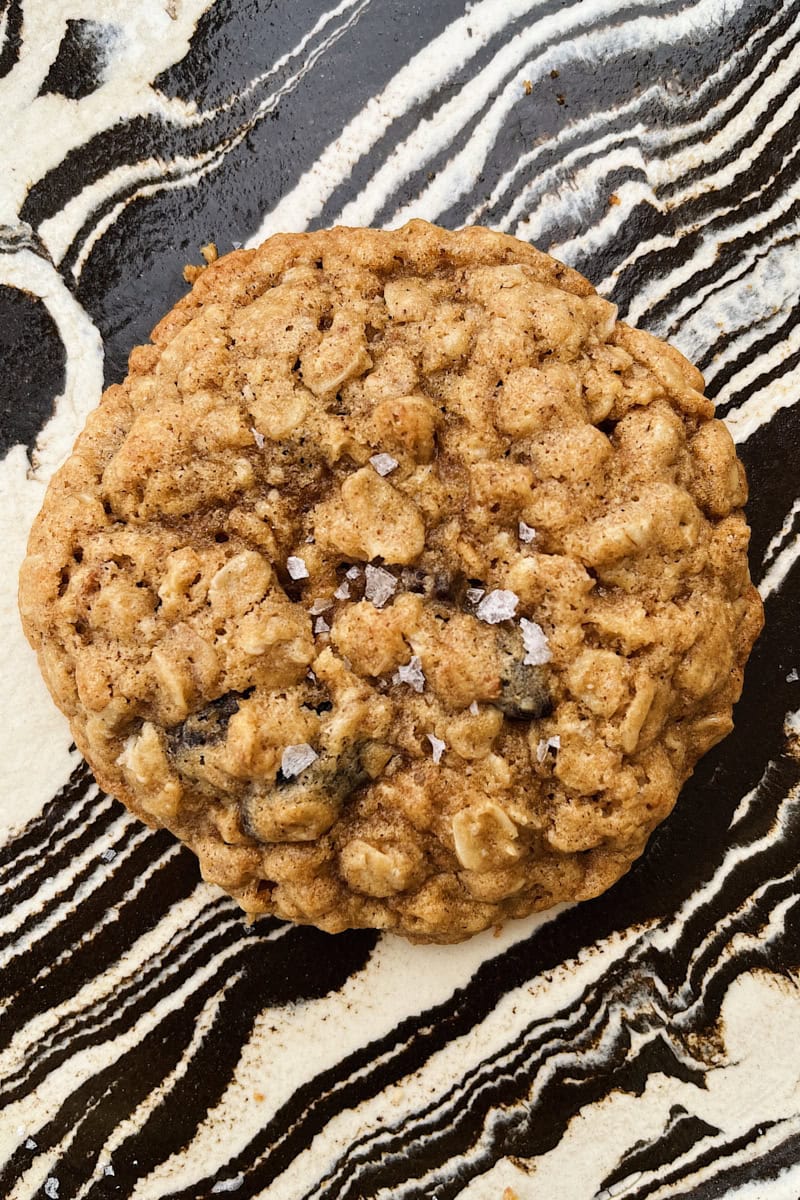
Use Sourdough Starter Discard to Replace the Omitted Water
Based on the amount of removed water from the butter (about 40 grams) and egg white (about 70 grams), I had room for 110 grams of liquid or 220 grams of starter. However, the difference of an extra egg white’s liquid and protein didn’t affect the dough’s ability to bind together, and as fat from yolks makes for a fudgier cookie, so I decided to omit that liquid. I landed on a total of 166 grams (3/4 cup) sourdough starter discard in the cookie dough. This made for a cookie that was moist and chewy, but not stodgy or overly tangy. This essentially means that the dough contains the liquid and fat equivalent of one whole egg and one egg yolk.
Use an Extra Egg Yolk, Brown Sugar, and Bread Flour For a Chewier Cookie
Because of the moisture the molasses in brown sugar brings to a baked good, it’s the only sugar used in this recipe. While whole eggs bring richness and heft, as noted earlier an extra egg yolk adds fudgy-chew. Finally, a high-protein flour like bread flour can create a slightly more dense, chewy baked good. While this is more apparent in a loaf of bread where the gluten is really developed through kneading, there is a subtly chewier texture to these cookies when made with bread flour than when made with all-purpose flour. (That said, I don’t feed my starter with bread flour so it’s not entirely as chewy as it could be.) The oats in the recipe make up the rest of the dough’s starch content, which thickens and stabilizes.
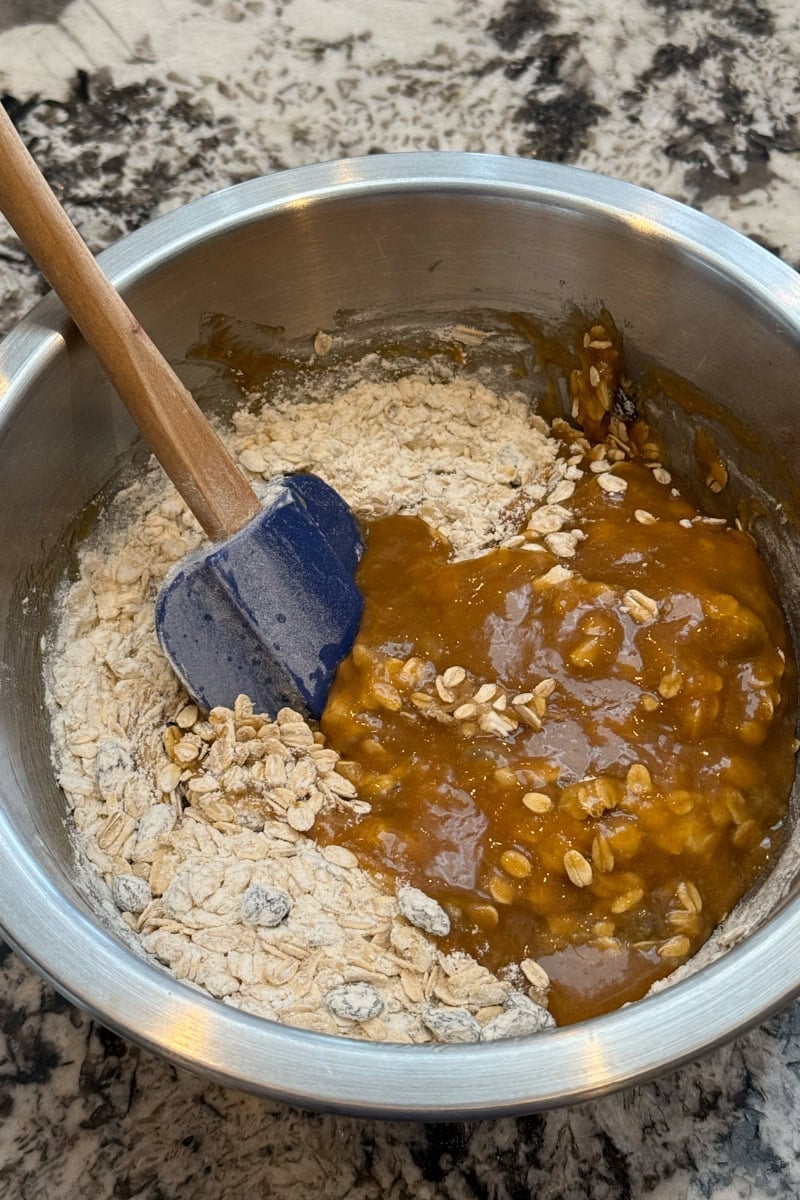
Baking Soda and Powder Help the Cookies Rise Just Enough and Get Golden
These cookies have acidity via brown sugar and sourdough starter, so technically they could be leavened with just baking soda; however I found the resulting cookies spread a little too thin and took on too much color in the oven. Adding a little baking powder in addition to soda helps the cookies lift just a bit, and turn just nicely golden brown.
Raisins Are Classic, But Other Mix-Ins Work Great
Oatmeal raisin cookies are so-named for a reason; the combination is classic. However, don’t feel you have to limit yourself. Consider swapping in dried cranberries or cherries, chopped dates or dried apricots, or even chopped candied ginger or dried citrus peel—they all work phenomenally well in these cookies.
Rest the Batter for Just Ten Minutes Before Baking
Unlike my sourdough chocolate chip cookies, which really benefit from an hour’s chill in the fridge, these cookies can be baked almost immediately. Letting the batter rest at room temperature for just ten minutes allows the flour to hydrate as much as it needs. Pull the cookies from the oven when they’re just set, which also helps with fudgy-chewiness.
Print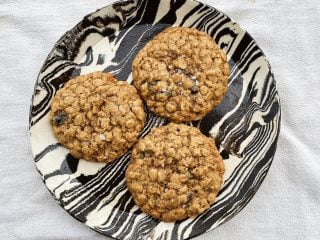
Chewy Sourdough Discard Oatmeal Raisin Cookies
- Author: Rebecca Firkser
- Prep Time: 30 minutes
- Cook Time: 30 minutes
- Total Time: 1 hour
- Yield: 20 cookies
- Category: Dessert, Snack, Lunch
- Cuisine: American
Description
Classic oatmeal raisin cookies using a bit of sourdough starter discard for a soft and chewy cookie with a tangy twist.
Ingredients
- 226 grams (2 sticks, 1 cup) unsalted butter
- 166 grams (3/4 cup) dark or light brown sugar
- 9 grams (2 teaspoons) vanilla extract
- 2 grams (1 teaspoon) ground cinnamon or cardamom
- 226 grams (2 cups) rolled oats
- 75 grams (½ cup) raisins
- 146 grams (1 cup plus scant 3 tablespoons) bread flour
- 6 grams (1 teaspoon) baking soda
- 3 grams (1 teaspoon Diamond Crystal or ½ teaspoon Morton) kosher salt
- 2 grams (1/2 teaspoon) baking powder
- 166 grams (3/4 cup) sourdough starter discard (unfed, 100% hydration)
- 28 grams (2 large) egg yolks
- Flaky sea salt, for sprinkling
Instructions
- Heat the oven to 350ºF with a rack in the center. Line two sheet pans with parchment paper.
- Place the butter in a small saucepan or skillet over medium heat. Melt the butter until it starts to foam and sputter, about 3 minutes. Whisking often, continue to cook the butter until it starts to quiet down, smells nutty, and turns deeply golden brown, 5 to 7 minutes. As you whisk, try to lift any browning milk solids that are stuck to the pot. Remove from the heat and immediately pour into a large heatsafe bowl placed over a digital scale, making sure to scrape in as many browned bits stuck to the pan as possible. You should have about 180 to 190 grams butter remaining. Immediately whisk the sugar into the hot brown butter until combined, then whisk in the vanilla and cinnamon. Let the mixture cool slightly while you prep the dry ingredients.
- In a medium bowl, stir together the oats, raisins, flour, baking soda, salt, and baking powder.
- To the large bowl with the butter mixture, whisk in the starter discard and egg yolks. Fold in the dry ingredients. Let the cookie dough sit at room temperature for 10 minutes.
Mixing browned butter and sugar into oat and flour mixture. - Use a #24/2.6-tablespoon cookie scoop to scoop out 7 dough mounds (about 50 grams each) onto one of the prepared sheets, at least 2 inches apart (if your sheet pan is too small, do 5 or 6 at a time). Roll each mound into a ball. Bake the cookies for 9 to 11 minutes, until the edges are lightly golden and the surface of the cookies are just set.
Super easy to scoop and roll. Photo by Rebecca Firkser. - While the first batch is in the oven, scoop another 7 dough balls for the second batch.
- Remove the first batch from the oven and let cool on the sheet pan for at least 5 minutes, then transfer to a wire rack to cool completely. (One that tray is free again, scoop the final 6 cookie dough balls.) Repeat with the second and third batch of cookies.
- Store cookies in an airtight container at room temperature for up to 1 week, or freeze for 3 months.
Discard Oatmeal Raisin Cookie FAQs
Can I make these cookies without eggs?
It won’t be exactly the same, but you can swap in a flax egg with less water to mimic the egg yolks. For each “yolk,” mix together 1 tablespoon ground flaxseed and 1 tablespoon water, so use a total of 2 tablespoons each ground flax and water. Let sit for 5 minutes to gelatinize a bit before adding to the dough.
Can I use vegan butter for these oatmeal raisin cookies?
If there’s a brand you regularly use that browns well, give it a shot!
Can I use a different flour if I don’t have bread flour?
Yes! All-purpose or whole wheat flour will work just fine as a substitute for bread flour here.
Can I use a different dried fruit if I don’t like raisins?
Yes! Dried cranberries or cherries work great, as do other roughly chopped dried fruit, such as dates or apricots. Chopped candied ginger or citrus peel are also excellent.
Can I add chocolate or nuts to these cookies?
Obviously yes! You can add about ¼ cup (43g) chopped preferred chocolate or chocolate chips and/or ¼ cup (43g) roughly chopped walnuts or pecans to the batter in addition to the raisins (the extra ingredients won’t mess up the batter); or swap out the entire amount of raisins for ¾ cup (129g) chocolate, nuts, or a mix of the two.
What’s Next?
Up for more sourdough discard cookies? Check out our sugar cookies, or all our sourdough discard recipes.


